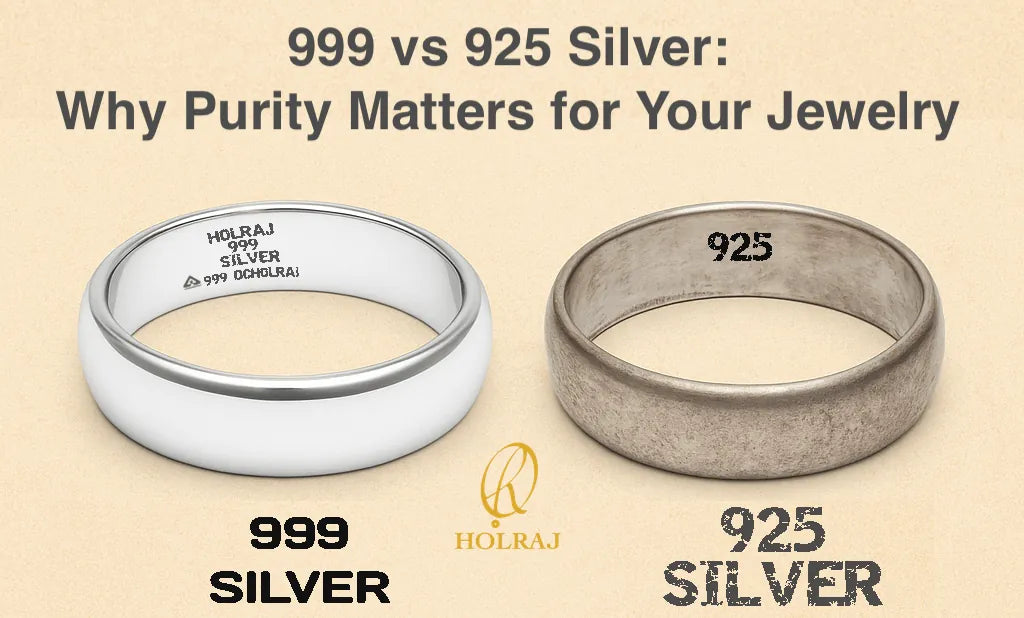
999 vs 925 Silver: What’s the Difference and Why It Matters
Share
999 vs 925 Silver: Why Purity Matters for Your Jewelry
Silver is timeless—but not all silver is equal. The difference between 999 and 925 silver affects purity, shine, cultural meaning, and what becomes an heirloom.
999 Silver: Pure and Precious
999 (fine) silver is 99.9% pure with only trace elements. It carries a bright, white luster, is BIS-hallmarked in India, and is traditionally chosen for coins, puja items, and heirloom pieces. Because it’s softer, designs must be crafted thoughtfully—yet that softness is part of its artisanal charm.
925 Silver: The Standard Alloy
925 (sterling) silver is 92.5% silver combined with 7.5% copper or other metals. It’s durable for daily wear, but the alloy tarnishes faster, can irritate sensitive skin, and lacks the intrinsic value and prestige of pure silver. For ritual, gifting, and legacy, 925 often feels “good enough,” not exceptional.
Quick Comparison
| Feature | 999 Silver | 925 Silver |
|---|---|---|
| Purity | 99.9% | 92.5% |
| Tarnish | Lower (no copper) | Higher (copper reacts) |
| Durability | Softer; artisan-grade | Harder; mass-market |
| Value | Greater intrinsic / heirloom value | Lower resale value |
| Cultural fit | Ideal for puja & gifts | Everyday alloy |
| Skin-friendly | Hypoallergenic | May irritate |
Why Holraj Chooses 999
- Uncompromising purity: Independent BIS hallmarking for trust.
- Heritage value: Pieces designed to be gifted, worn, and passed down.
- Cultural authenticity: Pakka chandi aligns with Indian rituals and blessings.
- Distinct aesthetics: A brighter, whiter shine than sterling.
👉 Discover our Rings & Bands Collection to see how purity elevates everyday style.
The Problems with 925
- Tarnishes fast — copper causes discoloration; frequent polishing or plating is common.
- Mass-market feel — ubiquitous alloy that lacks exclusivity.
- Lower intrinsic value — less precious metal content.
- Possible irritation — copper/nickel alloys can mark or irritate skin.
Heirlooms in Pure Silver (Parents, read this)
Pure silver isn’t just metal—it’s memory and protection. Our Regional Treasures Collection reimagines iconic Indian designs in 999 silver, creating pieces meant to be cherished for generations.
For babies: purity is non-negotiable. Feeding with alloys that contain copper or nickel can mean faster tarnish, off-tastes, and potential irritation on delicate skin. Choose BIS-certified 999 silver utensils like the RajAmrit spoon and AmritPatra bowl—the most loving standard of care, just as generations before us chose pure silver for their little ones.
Video: Why Pure Silver Matters
Final Word: Choose Purity, Choose Holraj
- 925 is durable and cheap—but it tarnishes, feels common, and holds less value.
- 999 is pure, luminous, hypoallergenic, and heirloom-worthy—deeply aligned with Indian traditions.
At Holraj, every piece is BIS-certified 999 silver—crafted to shine today and cherished for generations. Don’t settle for 92.5% when you can have 99.9%. Choose Holraj. Choose Pakka Chandi.
FAQ
Is 999 silver too soft for daily wear?
With mindful design and proper thickness, 999 silver is wearable for many styles. It may show character over time, which many customers love.
Does 925 silver tarnish?
Yes. Copper in sterling reacts with air and moisture, causing faster tarnish than 999.
